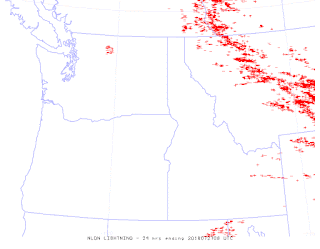But it all makes sense and is explained by lightning and winds.
By the time we get to mid-summer (after approximately July 15th), many of the "fuels" along eastern slopes of the Cascades (e.g., dry grasses, bushes, logging slash, dead trees) are dry enough to burn.
To get a fire, first one need an igniter. Humans start some fires: from fireworks, practice shooting, cars, cook fires, failing electrical systems, thrown cigarettes, and even arson. These fires tend to be in relatively accessible locations (e.g., roadsides) that can be controlled quickly.
Lightning fires are the other major source of ignition in our region and these fires are often in inaccessible locations and often in larger timber.
This week there was lightning over Washington and southern BC, just as western Washington went through a cool down period.
For example, the 24 hr ending 1 AM August 27th.
More range on the 28th.
Lots over the Cascades for the 29th.
And substantial amounts of southern BC for the 24 hours ending 1 AM on August 1.
The lightning resulted from the passage of an upper level trough (see map for 500 hPa on July 28th at 8 AM) that produced upward motion and unstable conditions over us.
This trough produced some cooling and the lightning initiated some fires. Then another trough moved in yesterday (see below) and resulted in a deepening marine layer, with the enhanced layer of cool air associated with high pressure over the western portion of the state and a larger pressure difference (gradient) across the State. Winds accelerated in gaps in the Cascades, the Cascade crest and the lee slopes on the eastern side.
To illustrate here are the max winds yesterday across WA state. Light winds over the west (gusts to 10-15 mph), but lots of 30-40 mph on the eastern side of the mountains, with some getting to 50 mph!
Max temperatures were way cool yesterday over the western half of Washington, but still toasty (90sF) over the east (see below). Relative humidities remained low over eastern WA as well.
So troughs brought lightning initiation of fires and then produced strong, gusty winds that stoked and drove the fires during the last few days.
How many fires now? Here is the latest map from the NW Wildfire Interagency Coordination Center. Several of the ones along the eastern slopes of the Cascades are the lightning/wind fires.
As the west warms during the weekend, the winds should weaken and the only lightning expected will be with some weak thunderstorms over the Cascade crest.
So conditions will be generally favorable for controlling the current fires and hopefully not initiating new ones.
It is essential for humans not to initiate fires in this period when lightning will be subdued.












Cliff, I'd be interested in some data on comparison of average percent of acreage burned (per unit time, per year, per decade, or whatever). Either by state or just a map showing regional percent of land burned nationally. Or it could be expressed as a risk that a randomly chosen site will burn, with data from hundreds of sites around the country. I'll bet that the west coast states have some of the worst, with our dry summers and extensive forests. Where can this be found?
ReplyDeleteAnsel,
ReplyDeleteDo a search for 'national wildfire database' and you'll find a very large volume of pertinent links.
Humans sadly aren't all that prescient(or smart)! If there's a cigarette to be tossed while it's still aglow, it will be. If there's bark dust, or bark chips, or some other flammable mulch for landscaping mulch, it will be used. If there's an especially flammable firecracker, it will be set off on a very dry July 4th.
ReplyDeleteDon't hold your breath expecting this fire season to be any different than any other (at least in the way of "Stupid People Tricks")!
Given that the huge fire in the Columbia River Gorge was started by a willful teenager, I can't argue with Tell Jorgensen's point.
ReplyDelete"...Michael F. Wehner, a senior staff scientist at Lawrence Berkeley National Laboratory. He stressed that there is no question that warming temperatures have led to severe droughts, meaning more dry fuel, as well as more intense heat waves. Those are essentially the conditions that have made for wildfire seasons that start earlier, last longer and affect larger areas.
ReplyDelete“To dismiss the role of climate change on these fires is simply incorrect,” said Mr. Wehner, who was a lead author on a chapter of the Fourth National Climate Assessment, a series of federal summaries of climate change data. He made the point, as most climate scientists do, that the cause of the wildfires is multifold, like in any complex event.
And this trend promises to continue: According to the National Climate Assessment science report released last year, the number of large forest fires in the Western United States and Alaska is projected to rise as the climate continues to warm...."
https://mail.google.com/mail/u/0/#inbox/WhctKJTrcRrgKvfQmmqFNcDcnkcNqzxsWXFfglQftlTFQpzLtprGcPPCDKqCDKjSswtWgnq
Fixed Carbon.... I think Michael Wehner is quite wrong.... climate change is a small part of this.. The big issue is mismanagement of our forests/wild areas and human expansion into the wildland. CA is always dry in the summer...that is not what has changed.. And the trend for fires has been downward, based on official CALFIRE stats...I will do blog on this...cliff
ReplyDelete